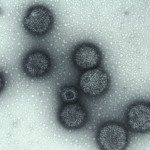Link to Pubmed [PMID] – 22760036
J. Clin. Microbiol. 2012 Sep;50(9):2974-81
Escherichia coli is the species most frequently associated with clinical infections by extended-spectrum-β-lactamase (ESBL)-producing isolates, with the CTX-M ESBL enzymes being predominant and found in genetically diverse E. coli isolates. The main objective of this study was to compare, on the basis of a case-control design, the phylogenetic diversity of 152 CTX-M-producing and 152 non-ESBL-producing clinical E. coli isolates. Multilocus sequence typing revealed that even though CTX-M enzymes were largely disseminated across the diversity of E. coli isolates, phylogenetic group B2 showed a particularly heterogeneous situation. First, clone ST131 of group B2 was strongly associated with CTX-M production (55 [79%] of 70 isolates), with CTX-M-15 being predominant. Second, the remaining members of group B2 were significantly less frequently associated with CTX-M production (9 [12%] of 75) than E. coli phylogenetic groups A, B1, and D (88 [55%] of 159). CTX-M-producing ST131 E. coli isolates were significantly more frequent in patients hospitalized in geriatric wards or long-term care facilities. Besides, the non-ESBL ST131 isolates significantly more frequently showed resistance to penicillins than the non-ESBL, non-ST131 isolates did. In conclusion, the present study emphasizes the particular antimicrobial resistance and epidemiologic characteristics of clone ST131 within group B2, which could result from the higher antibiotic exposure of this clone, as it is the predominant clone of group B2 carried in the human gut.

